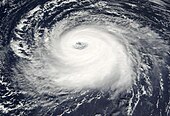
Back Nomenclature des cyclones tropicaux#Historique French Nomenclatura de ciclones tropicais Portuguese
| Part of a series on |
| Tropical cyclones |
|---|
 |
|
Outline Media coverage |
The practice of using names to identify tropical cyclones goes back several centuries, with storms named after places, saints or things they hit before the formal start of naming in each basin. Examples of such names are the 1928 Okeechobee hurricane (also known as the "San Felipe II" hurricane) and the 1938 New England hurricane. The system currently in place provides identification of tropical cyclones in a brief form that is easily understood and recognized by the public. The credit for the first usage of personal names for weather systems is given to the Queensland Government Meteorologist Clement Wragge, who named tropical cyclones and anticyclones between 1887 and 1907. This system of naming fell into disuse for several years after Wragge retired, until it was revived in the latter part of World War II for the Western Pacific. Over the following decades, formal naming schemes were introduced for several tropical cyclone basins, including the North and South Atlantic, Eastern, Central, Western and Southern Pacific basins as well as the Australian region and Indian Ocean.
However, there has been controversy over the names used at various times, with names being dropped for religious and political reasons. Female names were exclusively used in the basins at various times between 1945 and 2000 and were the subject of several protests. At present tropical cyclones are officially named by one of eleven meteorological services and retain their names throughout their lifetimes. Due to the potential for longevity and multiple concurrent storms, the names reduce the confusion about what storm is being described in forecasts, watches and warnings. Names are assigned in order from predetermined lists once storms have one, three, or ten-minute sustained wind speeds of more than 65 km/h (40 mph), depending on which basin it originates in. Standards vary from basin to basin, with some tropical depressions named in the Western Pacific, while a significant amount of gale-force winds are required in the Southern Hemisphere. The names of significant tropical cyclones in the North Atlantic Ocean, Pacific Ocean and Australian region are retired from the naming lists and replaced with another name, at meetings of the World Meteorological Organization's various tropical cyclone committees.